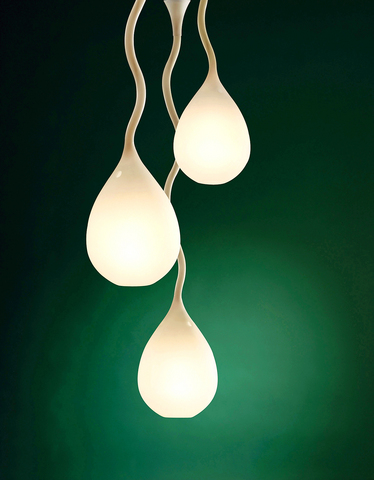Human skin is both dead and alive. It regulates the body's temperature and protects against the elements. It heals when cut and reveals much about the person who it covers. As such, skin is a multilayered, multipurpose organ that shifts across the landscape of the body and, for the current exhibition at the Museum of Contemporary Art (MOCA) called "Second Skin," it serves as both substance and metaphor in recent design practice.
Curated by Ellen Lupton, a researcher at Cooper-Hewitt, National Design Museum of the Smithsonian Institute, the exhibit originally opened in New York in 2002 under the title Skin: Surface, Substance and Design. As with the earlier exhibit, Second Skin uses installations, video, lighting, architecture, interior design, biotechnology, photography and clothing, to show the influence skin has had on contemporary design.
Second Skin has five sub-themes, each corresponding to the skin's functions and metaphorically dealing with design subjects.

PHOTOS COURTESY OF TFAM
The first category, called Beauty, Horror + Biotechnology, investigates the current obsession with aesthetic alterations of the body. Leora Farber's Four Minor Renovations: Revamp, Refurbish, Retouch, Refine, uses four videos to show the process of plastic surgery in all its grotesque beauty and is a statement of how — by altering the body — the line between what is natural and artificial is becoming increasingly blurred.
Thematically similar to Farber's video, Elke Gasselseder's Beauty, Horror and Biotechnology, is a montage of clips from Hollywood films about cyborgs, aliens and artificial life. It is difficult to distinguish between the natural and artificial skins in the shots.
Humans often wear artificial skins as a means of mediating the world. This notion serves as the underlying theme of Erotics of the Artificial and is poignantly revealed in Tonita Abeyta's line of latex clothing. As contemporary eroticism sometimes comes wrapped in latex, Abeyta has designed a line of latex garments for men and women, some of which come with built-in condoms. Nicola Costantino playfully eroticizes everyday objects such as soccer balls, handbags and shoes, by designing them with nipples and anuses — a surrealistic effect that is at once decorative and alarming.

The various garments found in the section Body Armors, evoke contemporary fashion designers' tendency to create garments that serve as portable environments in a world defined by leisure, terror and war.
Cooling System, a jacket designed by the US military and manufactured by Grando Zero Espace Ltd, evokes the feeling of separation from the environment by wearing protective skins.
Taking the luminescence of skin as its starting point, Luminous Objects, Luminous Surfaces is a series of objects that characterizes the delicate relationships between lighting and life. The multifunctional Jingzi Lamp designed by Herzog & de Meron resembles a giant, tail waggling, spermatozoon. Its exterior is made of silicon with the electronic components wrapped inside its translucent silicon skin.
Living Architecture, the exhibition's fifth category, investigates how challenges faced by contemporary architects today are differ from past considerations.
INVERSAbrane is a building material created by KOL/MAC, a two-man team of architects from New York, and serves the basic function of forming a hard, fire-resistant facade that can be freely adjusted to environmental conditions. The wall also functions as a collector of solar energy and can filter pollutants that are washed away with rainwater.
For existing structures, Jan and Tim Edler have invented a lighting system that converts the traditional surfaces of architecture into facades with continuously changing, computer-controlled video montages that morph passive buildings into ones that are active and alive. The architectural duo thus forms an uninterrupted dialogue with the public.

Sept.16 to Sept. 22 The “anti-communist train” with then-president Chiang Kai-shek’s (蔣介石) face plastered on the engine puffed along the “sugar railway” (糖業鐵路) in May 1955, drawing enthusiastic crowds at 103 stops covering nearly 1,200km. An estimated 1.58 million spectators were treated to propaganda films, plays and received free sugar products. By this time, the state-run Taiwan Sugar Corporation (台糖, Taisugar) had managed to connect the previously separate east-west lines established by Japanese-era sugar factories, allowing the anti-communist train to travel easily from Taichung to Pingtung’s Donggang Township (東港). Last Sunday’s feature (Taiwan in Time: The sugar express) covered the inauguration of the

The corruption cases surrounding former Taipei Mayor and Taiwan People’s Party (TPP) head Ko Wen-je (柯文哲) are just one item in the endless cycle of noise and fuss obscuring Taiwan’s deep and urgent structural and social problems. Even the case itself, as James Baron observed in an excellent piece at the Diplomat last week, is only one manifestation of the greater problem of deep-rooted corruption in land development. Last week the government announced a program to permit 25,000 foreign university students, primarily from the Philippines, Indonesia and Malaysia, to work in Taiwan after graduation for 2-4 years. That number is a

This year’s Michelin Gourmand Bib sported 16 new entries in the 126-strong Taiwan directory. The fight for the best braised pork rice and the crispiest scallion pancake painstakingly continued, but what stood out in the lineup this year? Pang Taqueria (胖塔可利亞); Taiwan’s first Michelin-recommended Mexican restaurant. Chef Charles Chen (陳治宇) is a self-confessed Americophile, earning his chef whites at a fine-dining Latin-American fusion restaurant. But what makes this Xinyi (信義) spot stand head and shoulders above Taipei’s existing Mexican offerings? The authenticity. The produce. The care. AUTHENTIC EATS In my time on the island, I have caved too many times to

In a stark demonstration of how award-winning breakthroughs can come from the most unlikely directions, researchers have won an Ig Nobel prize for discovering that mammals can breathe through their anuses. After a series of tests on mice, rats and pigs, Japanese scientists found the animals absorb oxygen delivered through the rectum, work that underpins a clinical trial to see whether the procedure can treat respiratory failure. The team is among 10 recognized in this year’s Ig Nobel awards (see below for more), the irreverent accolades given for achievements that “first make people laugh, and then make them think.” They are not